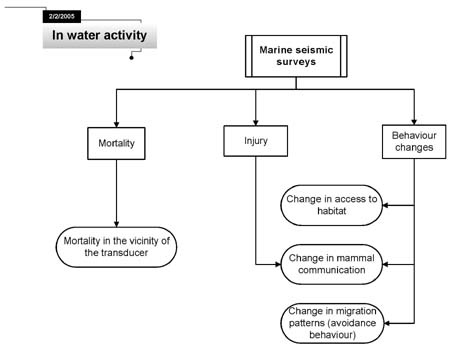Marine seismic surveys
In-Water Activities
- Addition or removal of aquatic vegetation
- Change in timing, duration and frequency of flow
- Dredging
- Fish passage issues
- Marine seismic surveys
- Organic debris management
- Placement of material or structures in water
- Structure removal
- Use of explosives
- Use of industrial equipment
- Wastewater management
- Water extraction
The undertaking of a marine seismic survey to determine the presence and/or structure of underground rock formations and often to determine the location of oil and gas wells. Energy or sound waves are passed into the rock and the reflected signals are recorded and analyzed. Large-scale surveys are conducted using a towed array of 'airguns' (cylinders of compressed air) which are discharged simultaneously to generate a pressure pulse which travels downwards into the earth.
NOTE:
Pathways of Effects diagrams have been developed by Fisheries and Oceans Canada as a tool to communicate potential effects of development proposals on fish and fish habitat and were developed through extensive consultation. It is expected that these diagrams will be updated to describe new activities and stressors as required.

Effects
Mortality in the vicinity of the transducer: Seismic work can affect fish and shellfish populations immediately after the sound waves have been discharged as well as afterwards. Fish, especially eggs and larvae, can be killed during and catch rates may drop immediately after a seismic survey.
Change in access to habitat/ migration: An alteration in water depth, flow, and/or substrate size causing a disruption in access to fish habitats essential for various life processes within given fish populations such as spawning and rearing.
Change in mammal communication: Marine mammals use sound to communicate and, in some cases, echolocate. The airguns used in seismic surveys generate sound at frequencies that overlap with those used by whales and dolphins and this acoustic disturbance has the potential to interfere with their natural functions, such as feeding, social interactions (including breeding) and navigation, as well as having the potential to cause physical harm.
Change in migration patterns: Dams may affect fish populations by preventing normal migration between feeding, rearing, and spawning areas and excessive flow and high water velocities can create migration barriers.
- Date modified: